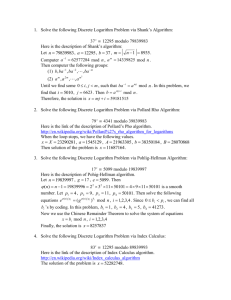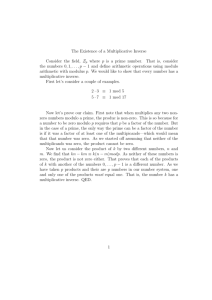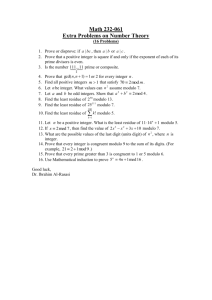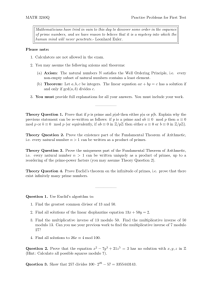COMMON FACTORS OF RESULTANTS MODULO p
advertisement
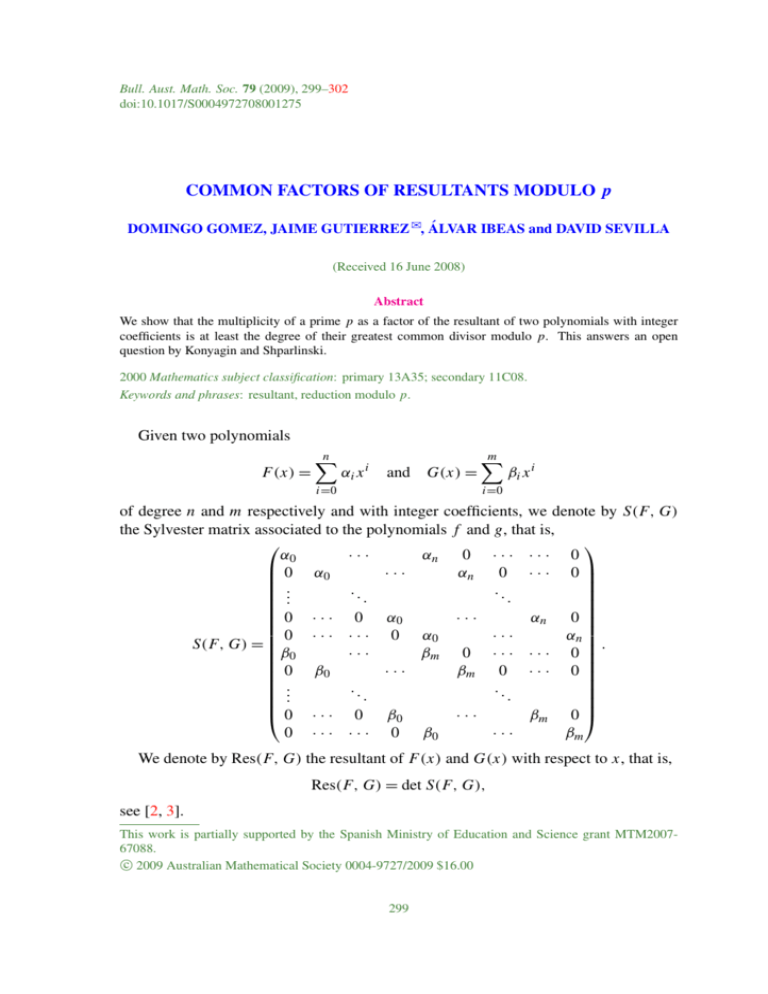
Bull. Aust. Math. Soc. 79 (2009), 299–302 doi:10.1017/S0004972708001275 COMMON FACTORS OF RESULTANTS MODULO p DOMINGO GOMEZ, JAIME GUTIERREZ ˛, ÁLVAR IBEAS and DAVID SEVILLA (Received 16 June 2008) Abstract We show that the multiplicity of a prime p as a factor of the resultant of two polynomials with integer coefficients is at least the degree of their greatest common divisor modulo p. This answers an open question by Konyagin and Shparlinski. 2000 Mathematics subject classification: primary 13A35; secondary 11C08. Keywords and phrases: resultant, reduction modulo p. Given two polynomials F(x) = n X αi x i and i=0 G(x) = m X βi x i i=0 of degree n and m respectively and with integer coefficients, we denote by S(F, G) the Sylvester matrix associated to the polynomials f and g, that is, α0 ··· αn 0 ··· ··· 0 0 α0 ··· αn 0 ··· 0 .. . . .. .. . 0 · · · 0 α0 ··· αn 0 0 · · · · · · 0 α0 ··· αn . S(F, G) = ··· βm 0 · · · · · · 0 β0 0 β0 ··· βm 0 · · · 0 .. . . . . . . . 0 · · · 0 β0 ··· βm 0 0 · · · · · · 0 β0 ··· βm We denote by Res(F, G) the resultant of F(x) and G(x) with respect to x, that is, Res(F, G) = det S(F, G), see [2, 3]. This work is partially supported by the Spanish Ministry of Education and Science grant MTM200767088. c 2009 Australian Mathematical Society 0004-9727/2009 $16.00 299 300 D. Gomez et al. [2] Let p be a prime. It is well known that if the polynomials F and G have a common factor modulo p then Res(F, G) ≡ 0 mod p. It is natural to consider the relation between the multiplicity of p as a factor of Res(F, G) and the degree of this common factor. In some special case, a positive answer to this question has been given in [1, Lemma 5.3] and the problem of extending this result to the general case has been posed in [1, Question 5.4]. Here we give a full solution to this problem. Let F G 6≡ 0 mod p and let d p be the degree of the gcd of the reductions of F and G modulo p. Let r p be the p-adic order of Res(F, G). Then the immediate result is d p > 0 ⇒ r p > 0. The following theorem is our result. T HEOREM . With the above definitions, dp ≤ r p. P ROOF. We shall prove the following result. Let H (x) be a polynomial of degree t such that its leading coefficient is not a multiple of p. If H divides F and G modulo p, then there exists α ∈ Z satisfying Res(F, G) = αp t . By the condition on the leading coefficient of H , there exist polynomials f (x) = r X bjx j and g(x) = j=0 s X ai x i i=0 with as 6≡ 0 mod p, r + t ≤ n, s + t ≤ m and satisfying F(x) ≡ H (x) f (x) mod p, G(x) ≡ H (x)g(x) mod p. We see that C(x) = F(x)g(x) − G(x) f (x) ≡ 0 mod p. We denote by Ri , i = 1, . . . , m + n, the row vectors of S(F, G). Recalling that C(x) = s X ai x i F(x) − i=0 r X b j x j G(x), j=0 we immediately derive that as Rs+1 + s−1 X i=0 ai Ri+1 − r X b j Rm+ j+1 ≡ (0, . . . , 0) mod p. j=0 Similarly, considering x k C(x), we obtain as Rs+k+1 + s−1 X i=0 for k = 0, . . . , t − 1. ai Ri+k+1 − r X j=0 b j Rm+k+ j+1 ≡ (0, . . . , 0) mod p, (1) [3] Common factors of resultants modulo p 301 We consider the matrix T obtained by replacing the rows Rs+1 , . . . , Rs+t with the rows as Rs+1 , . . . , as Rs+t in S(F, G). Clearly det T = ast det S(F, G) = ast Res(F, G). (2) Using (1) we see that, performing elementary row operations on the matrix T that preserve its determinant, we can obtain a certain matrix whose rows s + 1, . . . , s + t are zero vectors modulo p. Therefore det T ≡ 0 mod p t . Recalling that as 6≡ 0 mod p, 2 from (2) we conclude the proof. The presented proof is also valid for arbitrary unique factorization domains and modulo any principal prime ideal I = ( p). In particular, we have the result for any polynomial ring K [x1 , . . . , xn ][x] modulo an irreducible polynomial p(x) ∈ K [x1 , . . . , xn ][x], where K is an arbitrary field. On the other hand, the naive generalization of the original result, that is, d p = r p , is clearly false as it suffices to choose two polynomials with a common root. We provide an example that shows that the multiplicity can be strictly higher for pairs of polynomials with no common roots. E XAMPLE 1. The polynomials x 2 − 2x and x 2 − 2x + 2 have no common roots. Let F(x) = x · (x 2 − 2x), G(x) = (x − 3)(x 2 − 2x + 2). The greatest common divisor of F and G modulo 3 is x. However, Res(F, G) = 72 = 32 · 8. Finally, the next example shows that r p − d p cannot be bounded even if we bound the degrees of F and G. E XAMPLE 2. For any p > 2 and any k > 0, let F = x(x − 1) and G = (x − p k ) (x − 2). Then d p = deg x = 1 and r p ≥ k. Acknowledgement The authors would like to thank Igor Shparlinski for his interest and for posing this question. References [1] [2] [3] S. V. Konyagin and I. Shparlinski, Character Sums with Exponential Functions and their Applications (Cambridge University Press, Cambridge, 1999). R. Lidl and H. Niederreiter, Finite Fields (Cambridge University Press, Cambridge, 1997). B. L. van der Waerden, Modern Algebra (Frederick Ungar Publishing Co., New York, 1964). DOMINGO GOMEZ, University of Cantabria, E-39071 Santander, Spain e-mail: domingo.gomez@unican.es 302 D. Gomez et al. [4] JAIME GUTIERREZ, University of Cantabria, E-39071 Santander, Spain e-mail: jaime.gutierrez@unican.es ÁLVAR IBEAS, University of Cantabria, E-39071 Santander, Spain e-mail: alvar.ibeas@unican.es DAVID SEVILLA, Johann Radon Institute for Computational and Applied Mathematics (RICAM), Austrian Academy of Sciences, Altenbergerstraße 69, A-4040 Linz, Austria e-mail: david.sevilla@oeaw.ac.at
